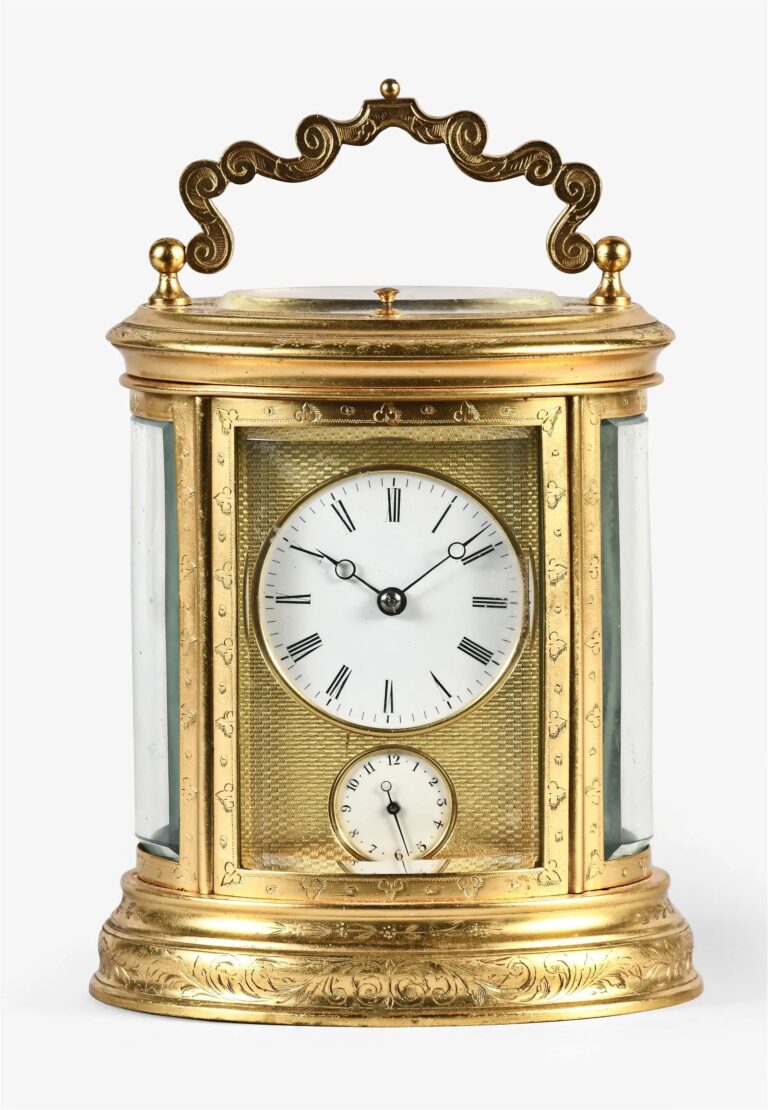I have a favorite saying as a seller of antique carriage clocks: “I only sell clocks I can lift.” This is why you do not see grandfather clocks on my website. The unique beauty of an antique carriage clock is that it features beauty in a small package. This makes it ideal for those with small spaces to display an antique clock. Other features are that they usually do not possess a pendulum, making the setup much easier to do without balancing a pendulum clock. Most carriage clocks run by what is referred to as an escapement.
According to Wikipedia, it is “a mechanical linkage in mechanical watches and clocks that gives impulses to the timekeeping element and periodically releases the gear train to move forward, advancing the clock’s hands. In lesser instances, a carriage clock may possess a Fusee movement. The Fusee movement was the same as that of a watch in those times. Some features on antique carriage clocks vs. their larger bronze brothers are that the better ones possess some lovely engraving on the bronze antique clock case and lack a pendulum. Other features of these lovely carriage clocks are, in many instances, the possession of a repeat of the last hour, half hour, or even fifteen-minute intervals, and an alarm within its tiny package.
The carriage clock’s origins can be traced back to a clock created for Napoleon at the end of the 18th century. The great French clockmaker Abraham Louis Breguet produced a pendulum officer (‘officer’s clock’) for the military leader.
Antique carriage clocks are truly a marvel of craftsmanship and history. They embody beauty in a small package that captivates collectors and enthusiasts alike. These exquisite antique clocks, often made from luxurious materials such as gilded bronze, brass, and fine wood, showcase intricate designs that reflect the artistry of their era. Each antique carriage clock tells a story—one that speaks of elegance, precision, and the passage of time.
Imagine holding an antique carriage clock in your hands; its delicate mechanisms ticking away with a rhythm that has endured for generations. The charm lies in their aesthetic appeal and functionality as portable timekeepers used by travelers in the last few centuries. Today, these antique carriage clocks serve as stunning decorative pieces while reminding us of the ingenuity of past artisans.
For those who appreciate history and craftsmanship, owning an antique carriage clock is like possessing a piece of art that transcends time. Whether displayed on a mantelpiece or passed down through generations, each carriage clock is a testament to human creativity and our timeless quest to measure life’s fleeting moments. Embrace the allure of antique carriage clocks and let them transport you to an age where beauty was crafted with passion and purpose!
ANTIQUE CARRIAGE CLOCKS AND THEIR NOTED MAKERS
“Carriage clocks are perennial favourites, and it’s easy to see why. With a myriad of case styles to choose from by some great makers, these little clocks are the perfect introduction to clock ownership.” James Stratton, Head of the Clocks Department in London
Some of the most noted makers of these small wonders of art were as follows:
Breguet: The noted French clockmaker Abraham Breguet produced what was probably the first carriage clock. At that time, he called it an “officer’s clock.” He created it for Napoleon Bonaparte so that it did not require a pendulum, allowing it to be transported without having to rebalance it.
Jacot: Henri Jacot of Paris is one of my favorites, in that while his antique carriage clocks were quite suppurb, many are still reasonably affordable in today’s market place. His carriage clocks feature his mark of a parrot.
Drocourt: Pierre Drocourt was a much sought after antique carriage clock maker, with a series of medals at Paris Exhibitions.
Frodsham: Charles Frodsham was a renowned English antique carriage clock maker. Frodsham was awarded the Telford Gold Medal and a medal for his clocks at the 1851 Great Exhibition. He was also honored at major exhibitions throughout the nineteenth century.
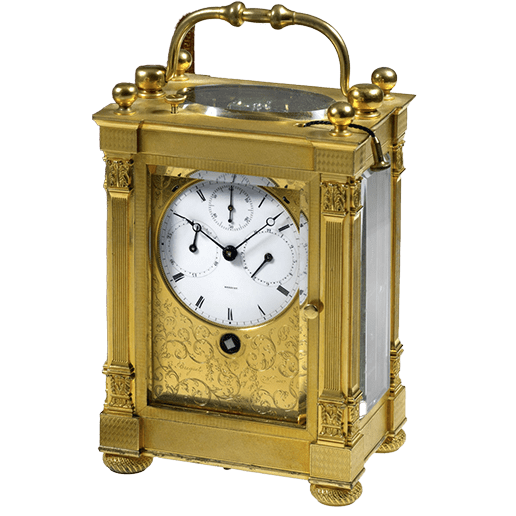 | 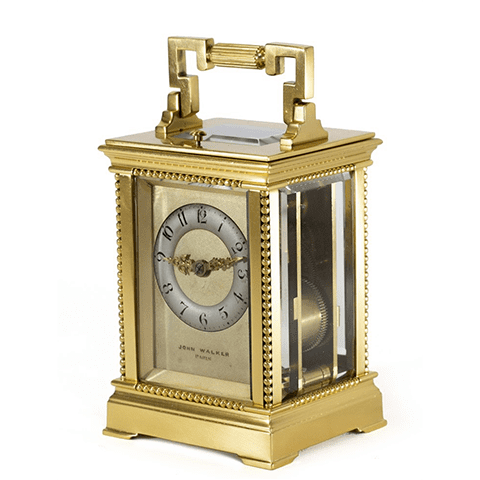 |
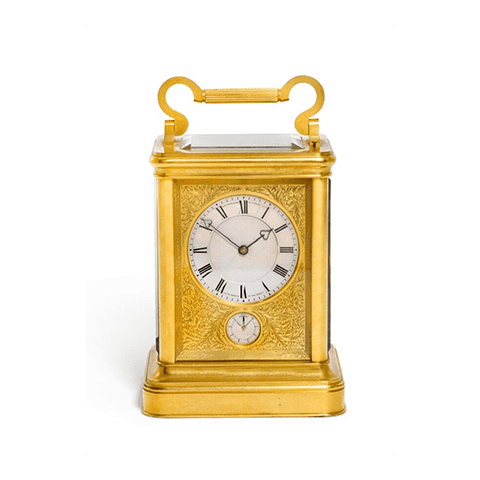 | 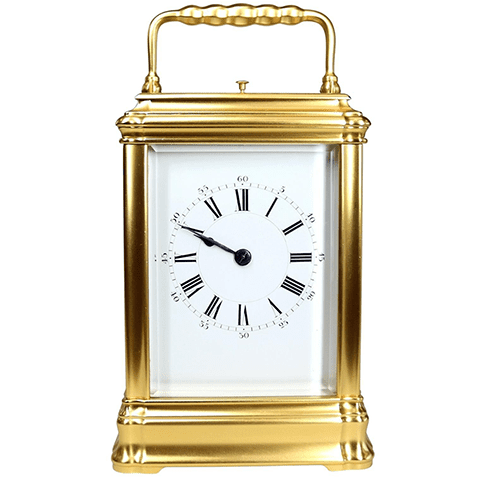 |
POPULAR SYLES OF ANTIQUE CARRIAGE CLOCKS
- Anglaise: A style associated with English carriage clocks.
- Art Nouveau: In the Art Nouveau style from around 1900-1910.
- Bamboo: As in the wood, popular in the late 19th century.
- Cannalee (Fluted): Similar to the Gorge style.
- Cariatides: Clock corners adorned with female mythological figures.
- Corniche: A typical case carriage clock shape utilezed around 1875-80.
- Gorge: Grooved cases favored by French makers.
- Doucine: A style with a serpentine or curved case.
- Oval: Cases with an oval shape, produced after 1850.
For a deep dive into carriage clocks, there is a comprehensive book on the subject by Charles Allix and Peter Bonnert entitled: “Carriage Clocks: Their History and Development”


